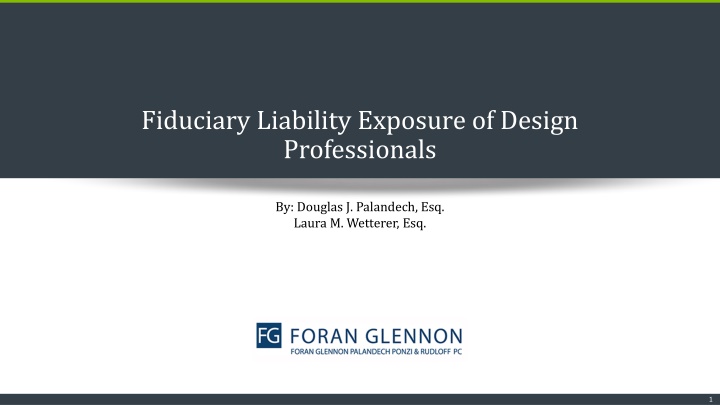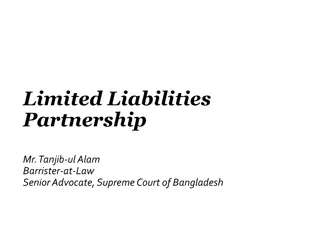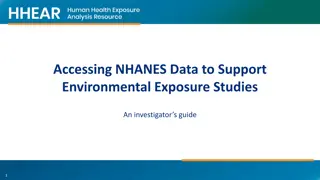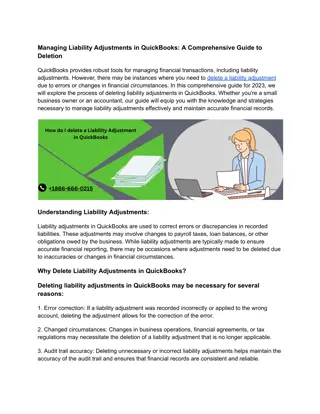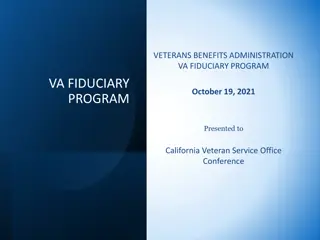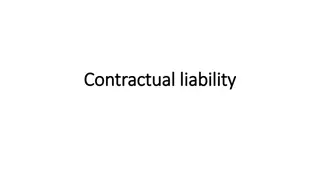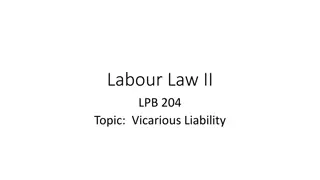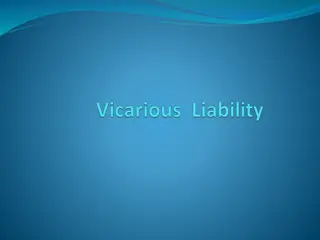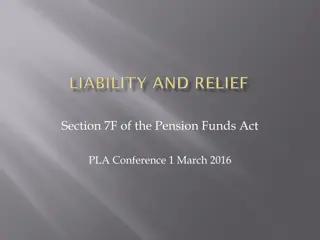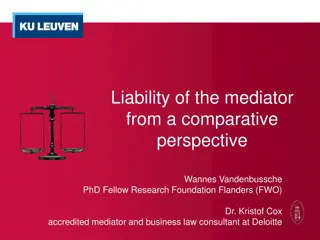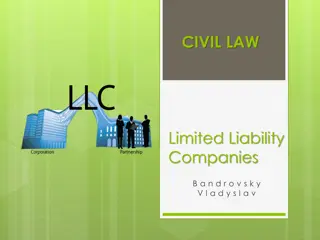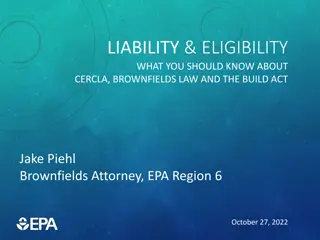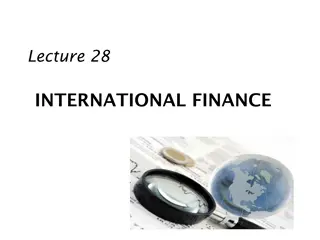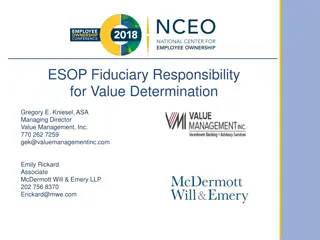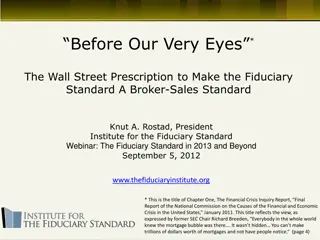Fiduciary Liability Exposure of Design Professionals
Design professionals may potentially owe a fiduciary duty to their clients, which goes beyond the standard duty of care. This duty includes acting in good faith, trust, and candor for the benefit of the client. Recognizing the legal exposures associated with assuming fiduciary duties is crucial in client engagements to mitigate risks.
Download Presentation

Please find below an Image/Link to download the presentation.
The content on the website is provided AS IS for your information and personal use only. It may not be sold, licensed, or shared on other websites without obtaining consent from the author.If you encounter any issues during the download, it is possible that the publisher has removed the file from their server.
You are allowed to download the files provided on this website for personal or commercial use, subject to the condition that they are used lawfully. All files are the property of their respective owners.
The content on the website is provided AS IS for your information and personal use only. It may not be sold, licensed, or shared on other websites without obtaining consent from the author.
E N D
Presentation Transcript
Fiduciary Liability Exposure of Design Professionals By: Douglas J. Palandech, Esq. Laura M. Wetterer, Esq. 1
Introduction Design professionals typically owe their clients a professional duty of care, i.e., to apply the degree of care and skill normally exercised by members of the community for the subject engagement. While not the law in most jurisdictions, it is possible that architects and engineers could owe a fiduciary duty, arising out of the owner/design professional agreement or relationship. 2
Introduction A lawsuit premised on breach of fiduciary duty has different claim elements and resultant damages than a suit premised on breach of standard of care. Because a design professional who assumes fiduciary duties has legal exposures different (and potentially greater) from those associated with deviation from professional standard of care, recognition of the possible consequences of such a duty must be factored in an engagement. 3
What is a Fiduciary? A fiduciary is a person who is required to act for the benefit of another on all matters within the scope of the relationship a person who owes another the duties of good faith, trust, confidence and candor. United States v. Milovanovic, 678 F.3d 713 (9th Cir. 2012), as amended (May 22, 2012) 4
What is a Fiduciary? First developed in equity courts, a fiduciary obligation is said to exist when one person (the client) places special trust and confidence in another (the fiduciary) in reliance that the fiduciary will exercise discretion and expertise with the utmost honestly and forthrightness in furthering the interests of the client. Id. 5
What is a Fiduciary? Examples of fiduciary relationships include those between: 1. A trustee and minor beneficiary; 2. The attorney-client relationship; and 3. The accountant-client relationship. 6
What is a Fiduciary? Generally, the design professional/owner engagement does not give rise to any sort of fiduciary duty as it is considered to be an arms-length commercial transaction (conventional business deal). Any perceived trust and confidence between the design professional and the owner is nothing more than the type normally existing before parties enter into a contract for services. 7
What is a Fiduciary? Fiduciary obligations constitute the highest standard of duty implied by law. D.A.B. v. Brown, 570 N.W.2d 168 (Minn. Ct. App. 1997). In simplest terms, the fiduciary acts for another s benefit. 8
What is a Fiduciary? The fiduciary s obligations are perhaps best explored by Supreme Court Justice Cardozo who wrote: Many forms of conduct permissible in a workaday world for those acting at arm's length, are forbidden to those bound by fiduciary ties. A trustee is held to something stricter than the morals of the market place. Not honesty alone, but the punctilio of an honor the most sensitive, is then the standard of behavior. As to this there has developed a tradition that is unbending and inveterate. Uncompromising rigidity has been the attitude of courts of equity when petitioned to undermine the rule of undivided loyalty by the disintegrating erosion of particular exceptions. Only thus has the level of conduct for fiduciaries been kept at a level higher than that trodden by the crowd. Meinhard v. Salmon, 249 N.Y. 458, 464, 164 N.E. 545 (128). 9
Fiduciary Obligations and the Design Professional Some states, few in number, have held that a fiduciary duty exists between design professionals and owners as a matter of law. Palmer v. Brown, 127 Cal. App. 2d 44, 59, 273 P.2d 306 (1954) (An architect owes to his client a fiduciary duty of loyalty and good faith); RCDI Const., Inc. v. Spaceplan/Architecture, Planning & Interiors, P.A., No. CIV. 100CV177, 2001 WL 1013241, at *5 (W.D.N.C. Jan. 25, 2001) (There is also a requirement of good moral character, N.C.G.S. 83A 7(a), which leads to fiduciary duties of an architect to his client, N.C.G.S. 83A 1(5)). Canton Lutheran Church v. Sovik, Mathre, Sathrum & Quanbeck, 507 F. Supp. 873 (D.S.D. 1981) (Architect-employer relationship under South Dakota law is a fiduciary relationship, particularly where architect has agreed to guard employer against defects and deficiencies in work of contractor through general supervision of construction work.). 10
Fiduciary Obligations and the Design Professional Other courts have found, after analyzing both the contract for engagement and the owner/design professional relationship that no fiduciary duties existed. 11
Fiduciary Obligations and the Design Professional In Todd Cty. v. Barlow Projects, Inc., a Minnesota court found that the architect s duties were established in the agreement which the design professional entered with that employer an architect is bound to perform with reasonable care the obligations for which it contracted and is liable for failing to exercise professional skill and reasonable care in preparing plans and specifications according to it contract. No. CIV.04-4218ADM/RLE, 2005 WL 1115479, at *10 (D. Minn. May 11, 2005) (quoting Strauss Veal Feeds, Inc. v. Mead and Hunt, Inc., 538 N.E.2d 299, 303); Munn v. Thornton, 956 P.2d 1213, 1220 (Alaska 1998) ( As fiduciary duties are reserved for relationships involving heightened levels of trust, we decline to create a fiduciary relationship between contractor and owner under a cost-plus contract. ). 12
Fiduciary Obligations and the Design Professional In Routh v. Preusch, the court emphasized the relationship between the client and architect (it) does not impose on the defendant the unique level of loyalty or trust which characterizes a fiduciary relationship. This is a breach of contract case, or one of professional negligence, which the plaintiff is attempting to enlarge into a case involving fiduciary duties without the requisite loyalty and trust that such a relationship requires. No. CV030197042, 2004 WL 2165906, at *2 (Conn. Super. Ct. Sept. 1, 2004). 13
Fiduciary Obligations and the Design Professional These decisions tell us that in states where no per se fiduciary duty exists between design professionals and owner, the contract language and the parties conduct can work to establish that relationship. 14
Contract Language Giving Rise to Fiduciary Duty Contract language is critical, if not determinative, in finding whether fiduciary duties exist in the design professional s engagement with the owner. In a written contract for architectural or engineering services, the design professional s duties are established in the contract for employment. 15
Contract Language Giving Rise to Fiduciary Duty Implicit in every contract for professional services is the architect s obligation to exercise skill and care which are commensurate with the services required under the contract. However, when the owner/design professional agreement includes contract provisions establishing a fiduciary relationship, courts will enforce that intention. 16
Contract Language Giving Rise to Fiduciary Duty The American Institute of Architects Standard Form of Agreement between Owner and Architect (AIA B101-2007) requires that the design professional: perform its services consistent with the professional skill and care provided by architects practicing in the same or similar locality under the same or similar circumstances. AIA B101-2007 2.2, Such a provision is the typical, professional standard of care. 17
Contract Language Giving Rise to Fiduciary Duty The Associated General Contractors of America s ConsensusDOCS 240, Standard Form of Agreement Between Owner and Architect/Engineer, provides: [t]he Architect/Engineer accepts the relationship of trust and confidence established by this Agreement and covenants with the Owner to cooperate and exercise the Architect/Engineer s skill and judgment in furthering the interests of the Owner. The Architect/Engineer represents that it possesses the requisite skill, expertise, and licensing to perform the required services. The Owner and Architect/Engineer agree to work together on the basis of mutual trust, good faith and fair dealing and shall take actions reasonably necessary to enable each other to perform the Agreement in a timely, efficient and economical matter. ConsensusDOCS 240 2.2. 18
Contract Language Giving Rise to Fiduciary Duty Paragraph 3.4 of the ConsensusDOCS 240 states that the design professional warrants and represents that its consultants are duly qualified, licensed, registered and authorized by law to perform the Services under this Agreement. 19
Contract Language Giving Rise to Fiduciary Duty Unlike the AIA form, the ConsensusDOCS 240 form discusses a relationship of trust and confidence and mutual trust, good faith and fair dealing. These terms could lead a reviewing court to find a fiduciary relationship, exposing the design professional to risk different than that existing under standard of care obligations. 20
Conduct Giving Rise to Fiduciary Duty Apart from contract language, the design professional s conduct during project performance can also give rise to a fiduciary relationship. When the relationship of architect and client is not per se a fiduciary one, the parties conduct might create such a relationship. 21
Conduct Giving Rise to Fiduciary Duty As mentioned, a fiduciary relationship exists where a party occupies a position of trust and confidence and has superior knowledge to the client s. Todd Cty. v. Barlow Projects, Inc., No. CIV.04-4218ADM/RLE, 2005 WL 1115479, at *9 (D. Minn. May 11, 2005) 22
Conduct Giving Rise to Fiduciary Duty In order to establish a cause of action respecting the existence of a fiduciary duty, parties can offer evidence of a moral, social, domestic or purely personal relationship of trust and confidence that existed prior to the contract. Sheffield Dev. Co. v. Carter & Burgess, Inc., No. 02-11-00204-CV, 2012 WL 6632500, at *10 (Tex. App. Dec. 21, 2012) 23
Conduct Giving Rise to Fiduciary Duty Courts will look to design professionals who are in positions of trust and confidence, i.e., where the design professional has superior knowledge. As opposed to being in a pure, arms-length business relationship, issues arise where the design professional engages in self-dealing or has a conflict of interest, particularly where the client is harmed. Managing a contractor or being considered the client s agent is an added risk as well. 24
What Facts Would Give Rise to a Breach of Fiduciary Duty? If a design professional is held to fiduciary standards, the liability issue differs from liability associated with deviation from professional standard of cares. As the two duties are distinct, conduct that doesn t violate professional standard of care metrics could constitute breach of a fiduciary duty. 25
What Facts Would Give Rise to a Breach of Fiduciary Duty? Examples include projects where an architect or engineer might have unusual construction administration responsibilities i.e., where the architect had a duty to investigate and warn the client of potential waste disposal problems on a project. Another case arose where an architect allegedly failed to disclose a defect she knew or should have known existed as a result of her general supervision of the construction site, i.e., construction administration and misrepresentations about site conditions. 26
What Facts Would Give Rise to a Breach of Fiduciary Duty? Likewise, financial relationships with other parties on projects could be potential risk - any slight conflict of interest could be considered a breach. An architect was found to have breached a fiduciary duty where he was also receiving payment from the project contractor without the owner s knowledge or consent. Another architect allegedly breached fiduciary duty for having a financial relationship with the contractor, combined with the architect s superior knowledge and experience on the project. 27
What Facts Would Give Rise to a Breach of Fiduciary Duty? Finally, any instance where a design professional makes a unilateral decision on behalf of the client also exposes him or her to more risk for any adverse consequences of that decision. In one case, an architect was sued for breach of fiduciary duty for the architect s failure to design a structure within the owner s budget. 28
What Facts Would Give Rise to a Breach of Fiduciary Duty? Fiduciary duties are not defined with the same specificity and rigor as duties associated with the professional standard of care. Logically, we can expect to see allegations of fact not neatly fitting into traditional claims supporting a breach of a fiduciary duty claim. 29
Insurance Coverage for Breach of Fiduciary Duty More troubling for design professionals is the issue of insurance coverage for an alleged breach of fiduciary duty. Under a standard A/E professional liability (PL) policy, the carrier agrees to defend and indemnify the design professional from its alleged or actual negligence where damage results from the design professionals deviation from standard of care. 30
Insurance Coverage for Breach of Fiduciary Duty While professional liability policies, products covering attorneys, cover breach of fiduciary duty claims, a design professional s PL policy would likely not provide coverage. 31
Insurance Coverage for Breach of Fiduciary Duty The A/E insuring agreement covers errors and omissions in the performance of design professional services; any allegations concerning a violation of trust or confidence would be outside policy scope. Even generously construing policy language, a breach of fiduciary duty would not be a covered peril. The design professional will likely have to corporately defend a lawsuit alleging breach of fiduciary duty as an uninsured risk. 32
Protecting Against Fiduciary Liability It would be judicious to include a provision in the contract for services explicitly negating the existence of any fiduciary duty. However, the enforceability of that provision remains unsettled. 33
Contracting Out of a Fiduciary Duty In some jurisdictions, parties can modify default rules of fiduciary duty through contract. Under New York law, for example, no fiduciary duty is owed where an explicit contractual disclaimer of fiduciary duty exists. Legal scholars have addressed the issue at length some assert that fiduciary duty cannot be waived by contract. 34
Contracting Out of a Fiduciary Duty As fiduciary duty theoretically exists for the protection of the (less sophisticated) beneficiary, it would be against public policy to allow waiver. Other authors maintain that fiduciary duties can be defined by contract under freedom of contract principles and should be tailored to fit the beneficiary s sense of vulnerability. Regardless, a provision intended to waive fiduciary duties will be the subject of court scrutiny. 35
Contracting Out of a Fiduciary Duty As such, it is important that any waiver of fiduciary obligations be specific it should be a clear and unambiguous expression of intention. Courts will also asses validity of a written waiver by examining the bargaining context and its commercial sensibility. Courts will want to make reasoned determination that the party waiving the duty is not being taken advantage of by the (allegedly more sophisticated) design professional. 36
Other Steps Design professionals can take several other affirmative steps to avoid the risk of fiduciary liability, particularly in drafting contracts. 1. The professional services agreement should reflect the independent contractor relationship while negating any suggestion of trust, confidence or superior knowledge qualifiers. 2. Have a defined scope of services in the contract, one which specially affirms the independent contractor relationship. 37
Other Steps Continued . . . 3. Have the contract reviewed by an attorney for any hidden suggestions of a fiduciary understanding. 4. Avoid any and all conflicts of interest on the Project, i.e., business/ financial relationships with any another project participant. 5. Emphasize the equal power of you and your client make it a collaborative process. Do not make unilateral project decisions on behalf of the client. 38
Conclusion While not currently the law in most states, many states have not addressed the issue of whether an architect or engineer can be held to the standard of a fiduciary. Architects and Engineers must be cognizant of the risks associated with an alleged breach of fiduciary duty and should take proactive steps to reduce those risks. 39
Q&A I welcome your questions and comments. 40
